For the first twenty years of its existence, the Hamilton & Dundas Street Railway (H&D) used steam engines to pull trains. Rather than the large mighty steam engines that we’re familiar with, these were small engines, capable of pulling only a few cars at a time. In order to prevent the engines from spooking horses, a wood shell in the shape of a streetcar surrounded the locomotive. This fake or dummy streetcar that was powered by steam was known as a steam dummy. The H&D had four steam dummies, numbered 1-4.
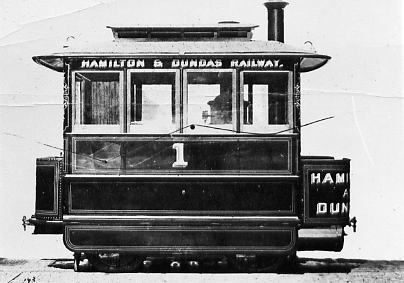
This is a builder’s photo of H&D #1, ordered in July 1878 and delivered by the Baldwin Locomotive Works in August, serial number 4395. An 0-4-0 locomotive, it was described by Baldwin's corporate notation as a 4-11C, model #29. The locomotive was originally painted olive green with red stripes and white pinstripes. Although they’re covered by the shell, the steam cylinders are 8” x 12”, and the locomotive tops out at 14 750 lbs.
H&D #1 was retired when the H&D was electrified on January 1, 1898, but was put back into service for a few days after an ice storm brought down the overhead wires on December 4, 1898. It was then sold to Charles Sturrock, the former H&D superintendent of motive power, who in turn sold it for scrap in 1900.
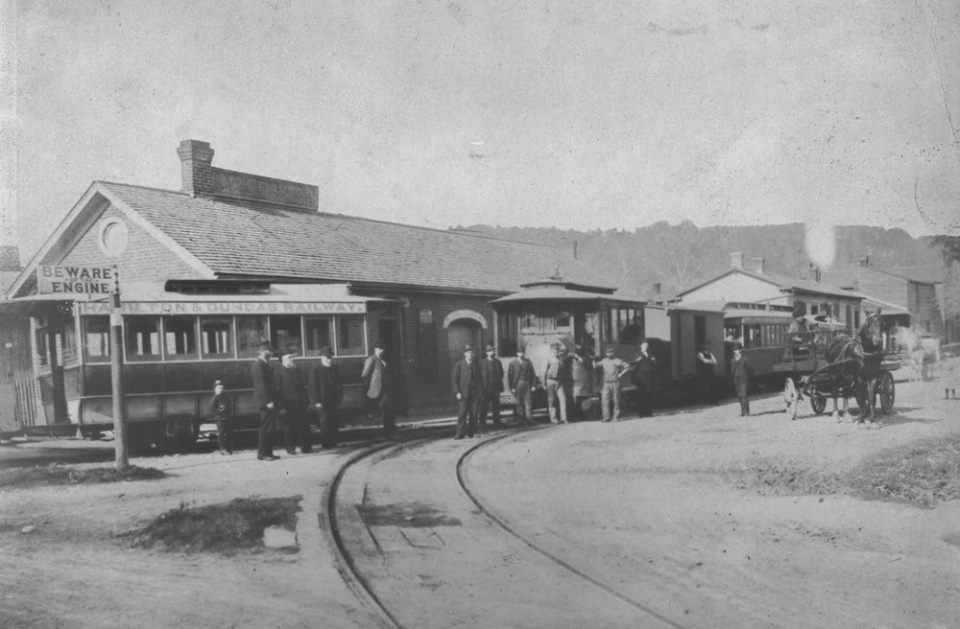
H&D #2 at the H&D's Dundas passenger station circa 1886. On the left is car #51, originally a horsecar from New York City. Behind the steam dummy is one of the H&D's boxcars and either car #16 or #18.
H&D #2 was ordered in March 1879 and delivered by the Baldwin Locomotive Works in May, serial number 4637. Also an 0-4-0 locomotive, it was described by Baldwin's corporate notation as a 4-14C, model #19. The locomotive was originally painted olive green with red stripes and white pinstripes. The steam cylinders were 10” x 14”, and the locomotive weighed 22 500 lbs. H&D #2 had a 5 window cab unlike #1 & #3.
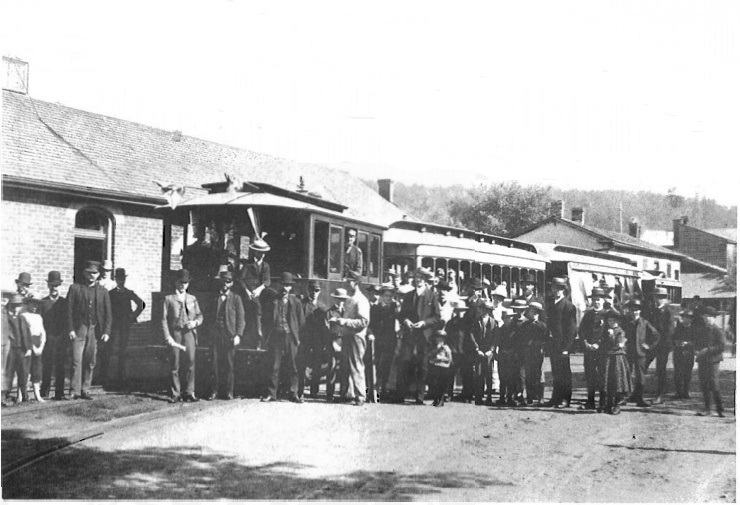
H&D #2 at the head of a train at Dundas Station, date unknown. From Canadian Rail, Nov-Dec 1991, pg 199.
H&D #2 was also retired when the line was electrified on January 1, 1898, and was also put back into service for a few days after the December 4, 1898 ice storm. It was then sold to Charles Sturrock, who in turn sold it for scrap in 1900.
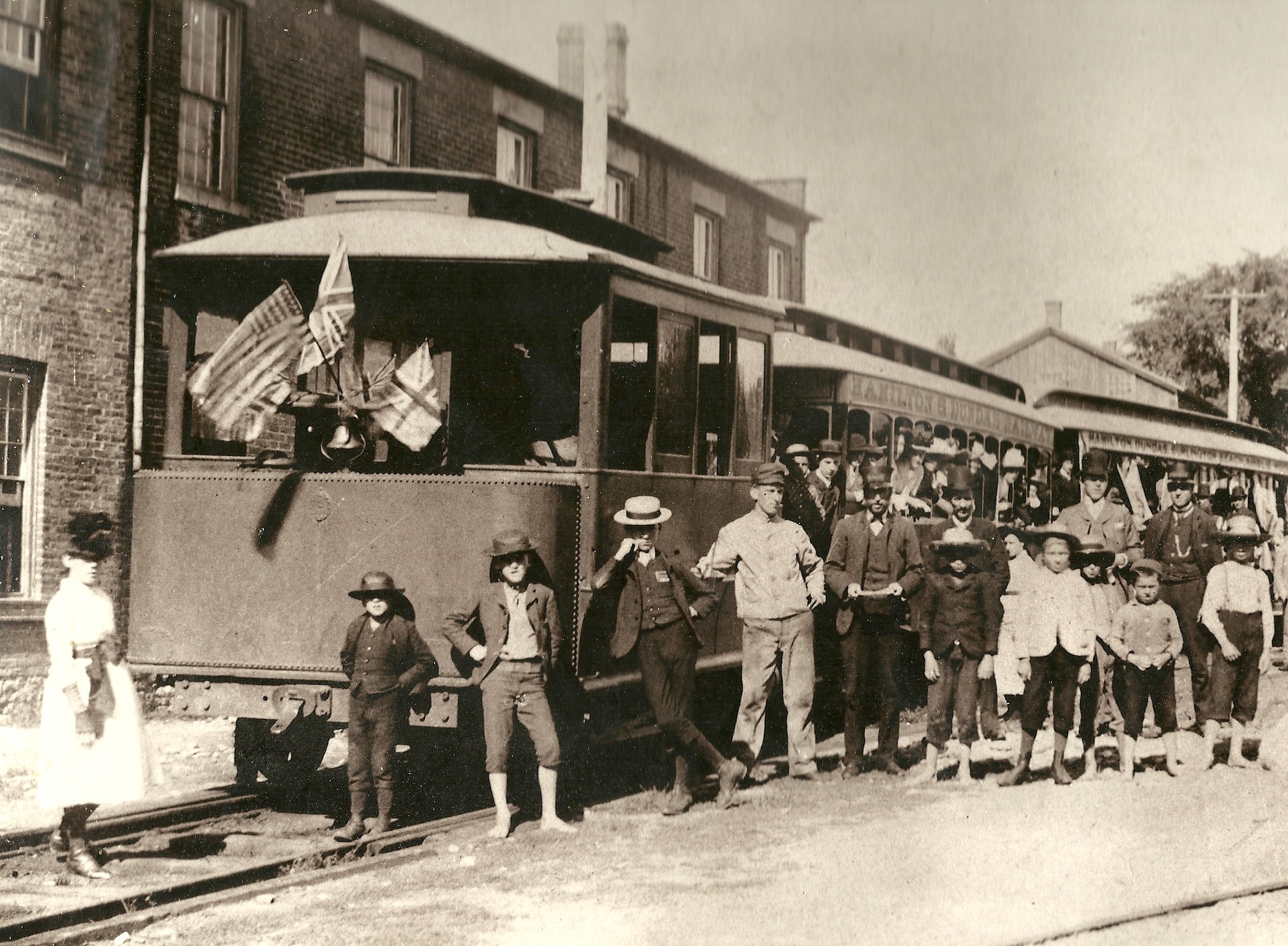
H&D #3 at the head of an excursion train on Hatt St in Dundas, date unknown. The photo is undated, but the American and British flags at the front of the train suggest that this is either a charter for a conference with representatives from Canada & the USA, or an excursion on July 4. (Photo courtesy of Brian Henley.)
Ordered in August 1879 and delivered by the Baldwin Locomotive Works in September (serial number 4774), H&D #3 had 10” x 12” cylinders and weighed 16 900 lbs. Also an 0-4-0 locomotive, it was described by Baldwin's corporate notation as a 4-17C, model #24. The locomotive was originally painted olive green with red stripes and white pinstripes.
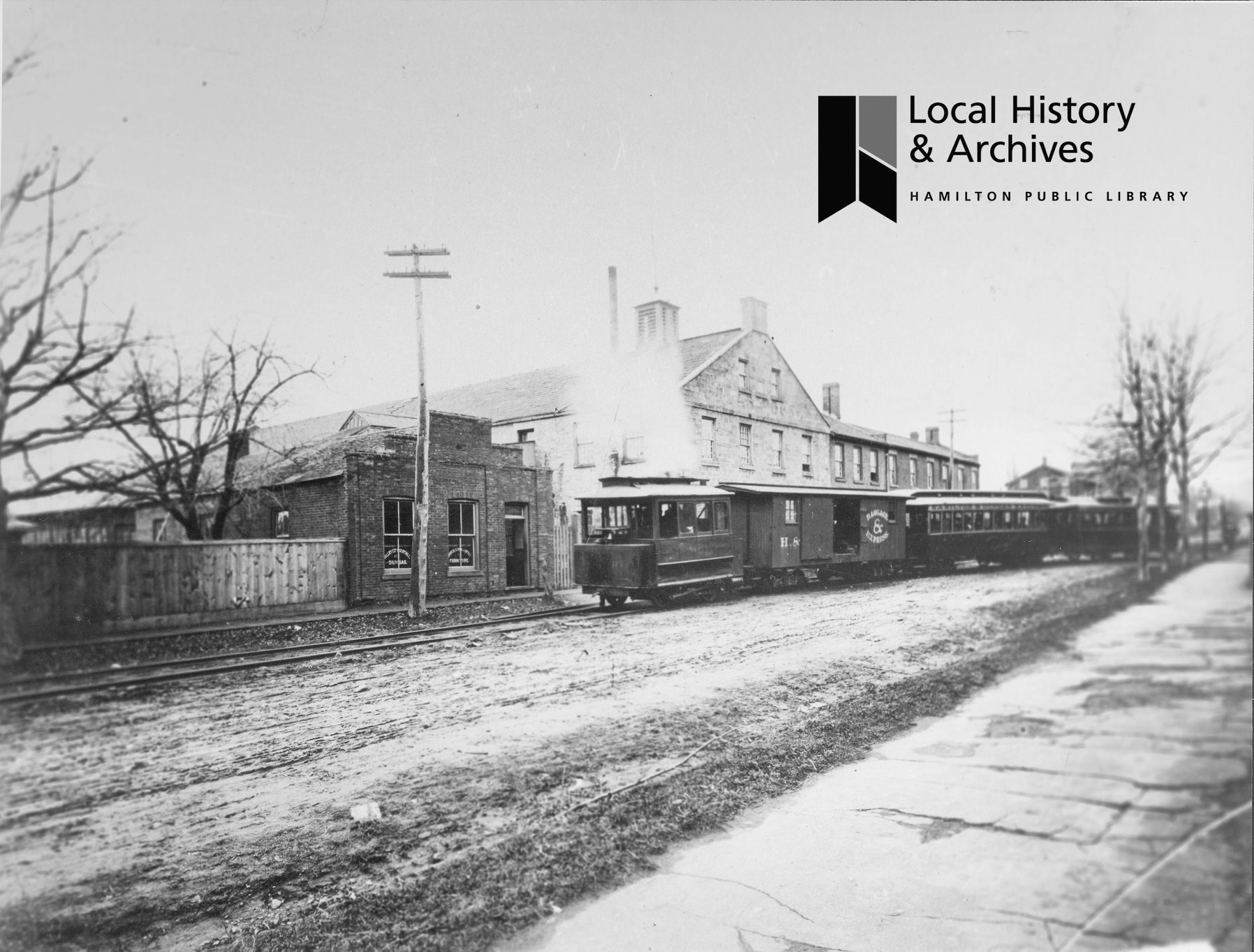
An H&D train pulls out of Dundas station circa 1891. The steam dummy is H&D #3. It's pulling an H&D boxcar, a closed passenger car, and one of the former New York City horse cars (H&D 51-55) that the H&D purchased and rebuilt into passenger trailers. (Photo courtesy of the Hamilton Public Library, Local History & Archives, used with permission)
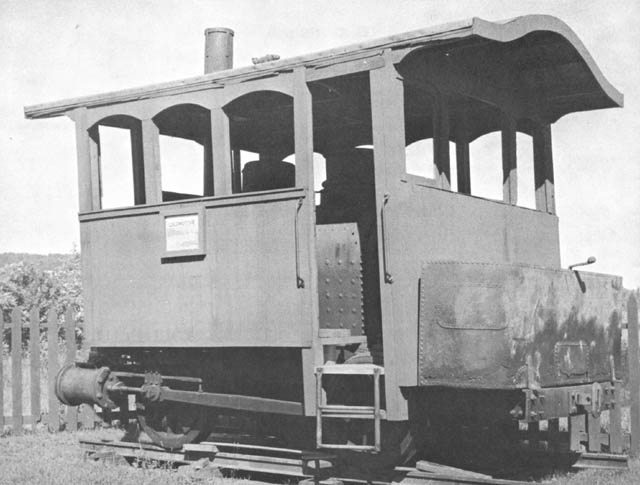
On October 9, 1897 H&D #3 collided with H&D #4 on the grade heading north out of the Chedoke Valley, near where Southview Place is today. Due to the damage from the collision and the planned electrification of the H&D, H&D #3 was not repaired, and was retired in 1898. Charles Sturrock bought this engine as well, but was then able to sell the engine to the C. Beck Lumber Co. of Penetanguishene, Ontario. The engine was rebuilt, and it worked until it was retired in 1924. (From the R.F. Corley collection, courtesy of Old Time Trains)
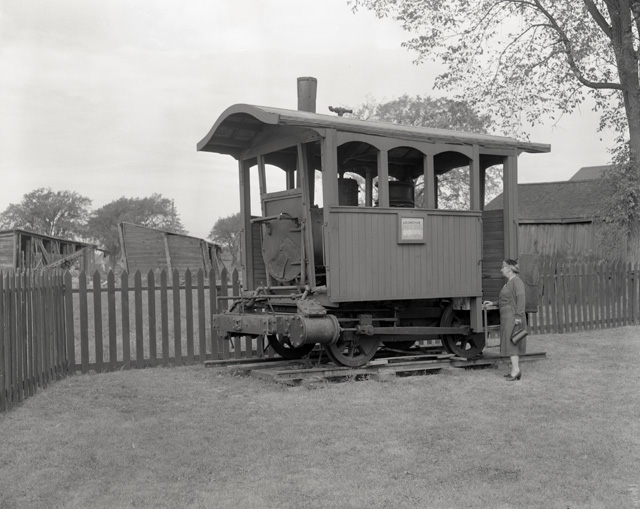
After its retirement, H&D #3 was mounted and put on display on the front lawn of the C. Beck Lumber Co. Bruce Murdoch photographed it on display on September 14 1957. (Photo courtesy of the Hamilton Public Library, Local History & Archives.)

In 1967 the offices of the C. Beck Lumber Co. would become the Penetanguishene Centennial Museum. H&D #3 remained on site as part of the museum's collection. This photo was taken by Eric May in February 1995 (used with permission)
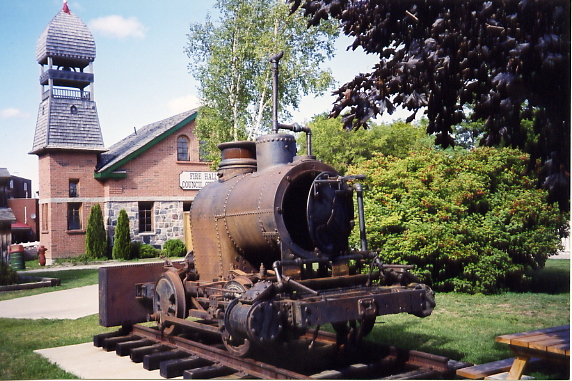
I visited Penetanguishene in August 2004 to see H&D #3. By this time, the wooden shell had been removed, and the steel was rusting away. As I took my photos, I wondered if anything could or would be done to save this little engine from disintegrating.
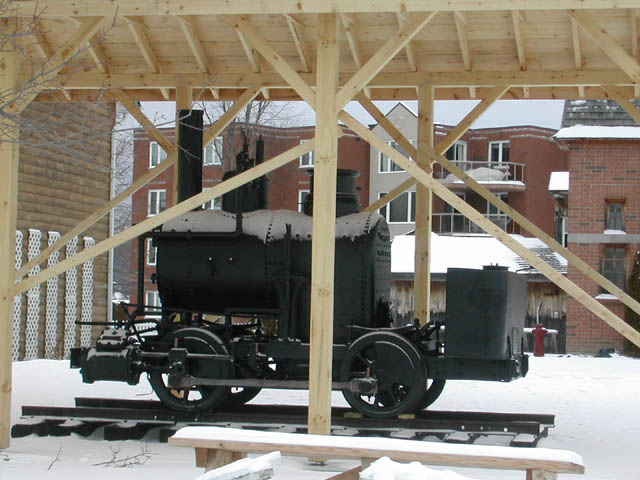
Fortunately, there was. As part of a Trillium grant, the Penetanguishene Centennial Museum was able to give H&D #3 a cosmetic restoration. Over the next few months H&D #3 was restored through the hard work of John Vincent of Lindsay. At the same time a shelter was placed over it for protection, as these photos by Eric May in January 2005 show. (Photo courtesy of Old Time Trains)
H&D #3, July 30, 2020. (1, 2, 3, 4) (Photos courtesy of Charles Darrow)
H&D steam dummy #4 with trailer #20 at the H&D Dundas passenger station, March, 1897. Ordered in November 1896 and delivered by the Baldwin Locomotive Works on January 2, 1897 (sn 15125, 7” & 12” x 14” cylinders as a Vauclain Compound, 28900 lbs). Also an 0-4-0 locomotive, it was described by Baldwin's corporate notation as a 4-8/18C, model #1. Unlike the other steam dummies, H&D #4 was originally painted bottle green with gold stripes and lettering.
H&D steam dummy #4 date and location unknown. This engine saw the least amount of service on the H&D of any of the steam dummies, being delivered 12 months before the start of electric operations. It was ordered by the H&D due to the age of the other three steam dummies, and to act as a warning to the local town councils that the H&D was willing to remain a 'dirty, noisy steam railroad' if they wouldn't approve bylaws for electrification of the system. H&D #4 was probably the last steam dummy engine built in North America, and the first steam dummy built as a Vauclain Compound. This compounding of the steam cylinders was designed to make the engine more powerful than its counterparts, and allow it to take heavy freight trains uphill with no additional help or fuel. This requirement was not needed when the TH&B negotiated trackage rights into Dundas, and got the freight cars there and back itself. When the line was electrified the engine was retired, but was also put back into service for a few days after the December 4, 1898 ice storm.
H&D #4 was subsequently sold in 1902 to assist with the construction of the Preston & Berlin radial line. It stayed with that railroad until late 1909 when it was sold to the Nipissing Central Railway to haul ballast trains and passenger cars before the overhead wires were installed. (From the collection of John Weatherburn, courtesy of the Canadian Heritage Photography Foundation)
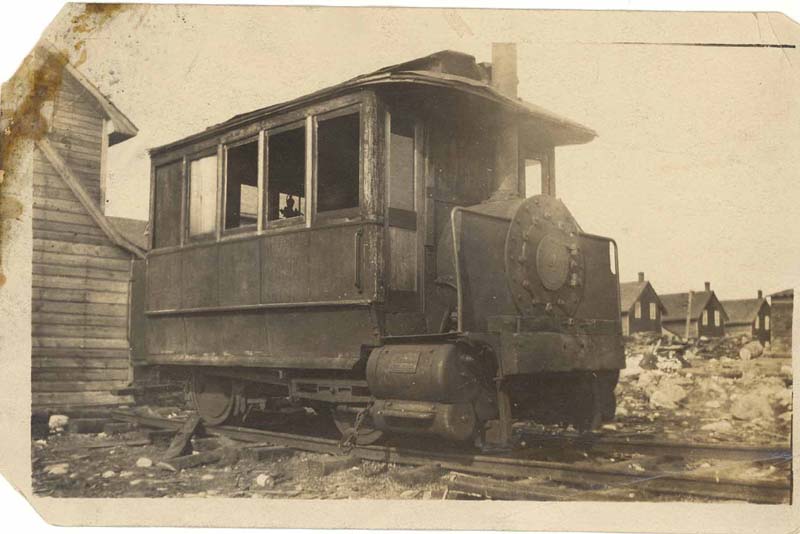
At some point H&D #4 was bought by the William Milne & Sons Company. It was first used near North Bay at Trout Mills, and later on it went to their operation in Temagami in 1935. Like the date and location of this photo, the fate of H&D #4 is unknown. (From the collection of Brian Westhouse, courtesy of Old Time Trains)
The 4 steam dummies were similar in appearance, but each one was unique. As a result when examining old photos it's possible to figure out which is which even if the numbers cannot be seen. #1 & #3 had 4 window cabs, #2 & #4 had 5 window cabs. #1 & #3 can be distinguished from each other by examining the rear water tank. #3's reached the bottom of the windows, #1's did not. #4 was the largest of the 4 and had distinctive 3 chamber steam cylinders while #2 was similar in size to #1 & #3 with ordinary steam cylinders. Be advised that H&D #3 was repaired after the collision on October 9, 1897, and so some features as it is now won't match old photos.
Sources
Baldwin Locomotive Works Engine Specifications, 1869-1938
Volume 8, pg 255
Volume 9, pg 111, pg 186
Volume 20, pg 239
"Electric Railway Notes" The Railway and Marine World. December 1909, pg 933
Hamilton Spectator
"Had a Head-on Collision - Bad Wreck on the H. and D. Road Early this Morning" October 9, 1897, pg 1
"Fixing the Wires" December 6, 1898, pg 1
Mills, John M. Cataract Traction; The Railways of Hamilton. Toronto: Upper Canada Railway Society/Ontario Electric Railway Historical Association, 1971